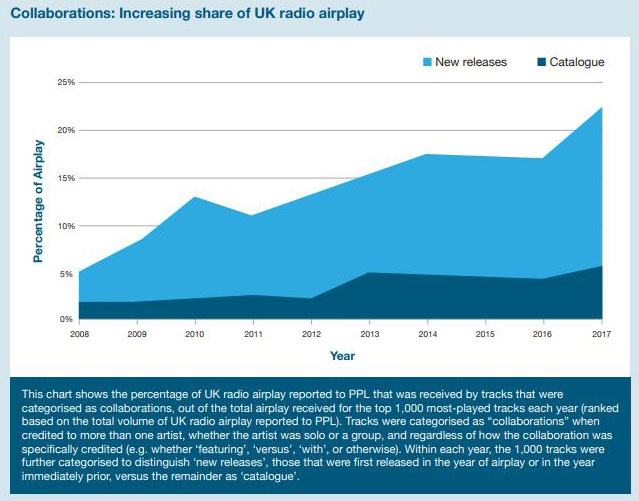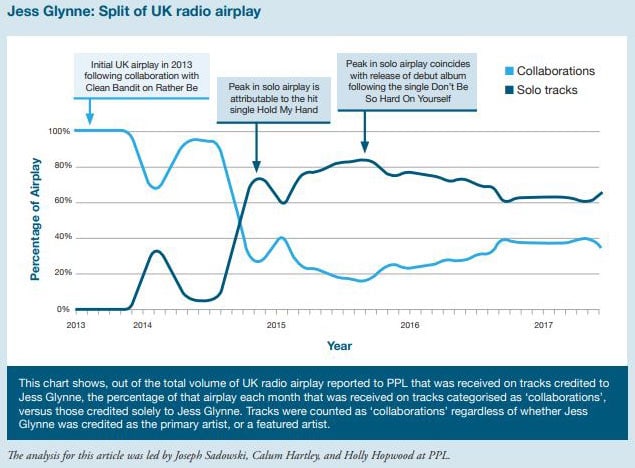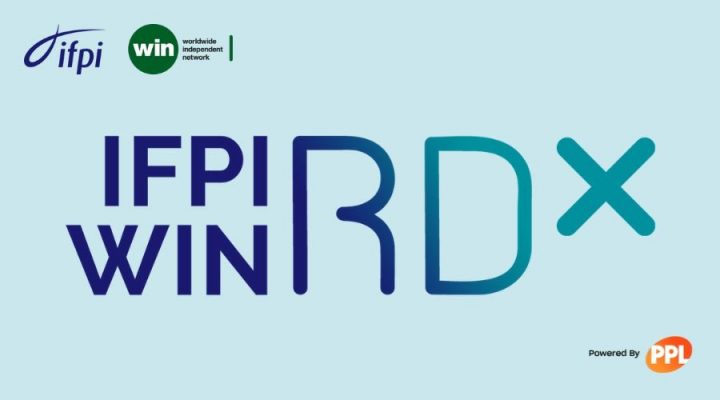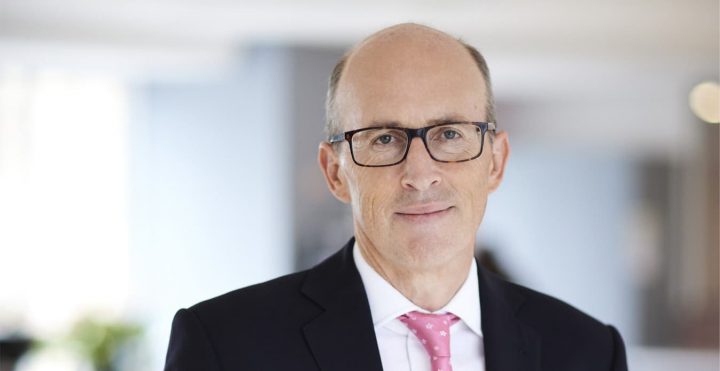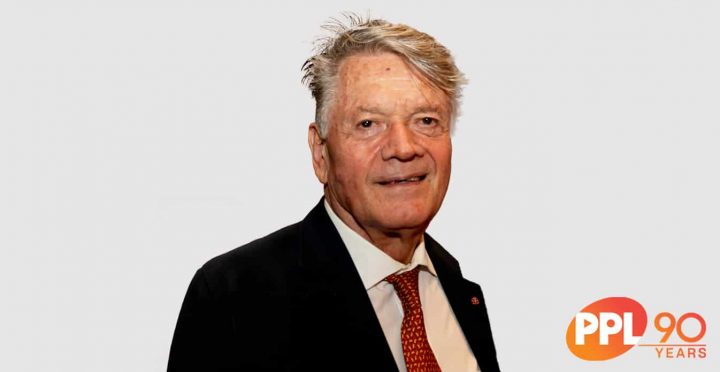It was ten years ago PPL reported that “Umbrella”, Rihanna’s collaboration with Jay-Z, was top of the 2007 PPL ‘most played’ chart (compiled annually from UK radio and TV airplay data reported to PPL, along with some public performance data). The combination of solo vocalist and rapper was not a new one – and collaborations have long been commonplace in genres like Hip Hop and R&B – but, in hindsight, that year signalled the beginning of a marked trend in mainstream music. Until then, tracks by a single group or a solo artist had typically dominated the UK sales charts, and commanded the majority of UK radio airplay reported to PPL.
It took six years before a collaboration was again PPL’s Most Played track of the year (Get Lucky by Daft Punk ft. Pharrell Williams in 2013), but we have seen the share of UK radio airplay going to collaborations growing steadily throughout, and it is now more than four times what it was ten years ago.
While ‘catalogue’ collaborations have increased in share of UK radio airplay, most of the trend is driven by new releases, and the impact of this can also be seen in the weekly Official UK Singles Chart: 8 of the 14 tracks that topped the chart in 2017 were collaborations. And the first new track to reach no.1 in 2018? A collaboration (Eminem ft. Ed Sheeran).
Are data-savvy labels and management teams working with their artists to benefit from this apparent trend? On the face of it, it seems obvious that collaborating on a track will give it the potential to appeal to a broader fan base. To investigate this, we analysed the UK radio airplay for the top 1,000 tracks (ranked by volume of airplay reported to PPL) released in each of the last five years. Sure enough, we found that, on average, the tracks on which an artist (whether solo or a group) had collaborated received 2.8 times as much airplay in the first 12 months compared with those tracks where the same artist had not collaborated. Moreover, this ‘airplay uplift’ has been steadily increasing by around 10% each year.
This would lead some to suggest that collaborating is a sure-fire route to increased radio airplay. But there is a catch hidden behind the words “on average”. Looking closely, only half of the artists who had collaborated in this period received any airplay uplift on those tracks, and the other half actually had less airplay on the tracks they had collaborated on.
So, is it that not all collaborations have quite the right chemistry? We further crunched the UK radio airplay data for our 5-year sample of top tracks to see what else we could learn.
The more the merrier
The majority of collaborations are between just two artists, but the average radio airplay increased with each additional artist: tracks where three artists worked together received 48% more airplay on average than those with two, and those with a fourth collaborator gained a further 22%. There is a long history of collaboration amongst rappers and in R&B, and we found that Lil Wayne, Pharrell Williams, and Kanye West are some of the artists who received the most airplay as part of bigger collaborations.
There are some truly prolific collaborators
The ten most prolific collaborators collectively accounted for 20% of the airplay received by all artists across their “collaboration” tracks. Nearly two thirds of the 130+ biggest hits these artists have released in the last 5 years have been collaborations. Working with any of these artists appears to have had a big impact on airplay – perhaps not surprising when you consider that this list includes the likes of Rudimental, Clean Bandit, Daft Punk, and Rihanna.
Calvin Harris is another prolific collaborator, and when his track “Feels” (featuring Pharrell Williams, Katy Perry, and Big Sean) topped the Official UK Singles chart in August 2017, it became his seventh UK no.1 of this decade – leaving him with the joint-highest total of all chart-topping artists. But who does he share this honour with? None other than Tinie Tempah, himself a regular collaborator on his chart-toppers.
Collaboration might kick-start a career
The airplay history for some individual artists suggests that when the chemistry is right, the impact of a collaboration can be significant. Sam Smith launched his career working with the likes of Disclosure and Naughty Boy. And, Craig David returned to the scene in 2016 releasing successful collaborations with Big Narstie and Blonde.
Jess Glynne’s debut album was much-anticipated following the success of her earlier collaborations with Clean Bandit and Route 94. Will we see her repeat this pattern with a second album in 2018, following her successful collaboration with Rudimental on “These Days”?
“Collaborations can be a great way of helping to build an artist’s career over multiple releases. In the run up to Jess’ debut album, collaborations such as “Rather Be” helped to raise awareness, introduce Jess to the market, allow the media to trust her as a hit vocalist and let her be in the market whilst she developed and grew as an artist proposition. Now that we are approaching her second album, collaborations do still play a part in allowing Jess to engage with different segments of her audience whilst providing her a longer runway for building anticipation for her own major solo release.” – Sam Eldridge at UROK Management
So, what else could we expect to see in 2018? Inspired by Ed Sheeran’s genre-bridging collaboration with Andrea Bocelli on “Perfect Symphony” at the end of last year, and Sting and Shaggy’s forthcoming joint album, we analysed some station-level UK radio airplay data to identify which combinations of artists could potentially generate the greatest coverage.
Much like Heston Blumenthal’s ice cream flavours, many of the suggested collaborations we came up with didn’t seem instantly appealing. But some did. For example, we’d certainly be excited to hear that The Who were working with Bruno Mars. Or that Blondie were collaborating on a track with Coldplay. Likewise, a duet between Adele and Ludovico Einaudi. But we’ll leave you with our favourite: who wouldn’t want to see Elton John performing with Katy Perry, perhaps on his Farewell tour?
